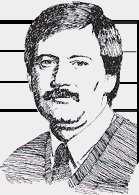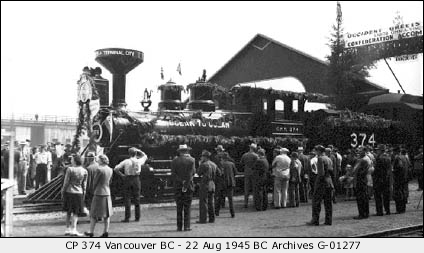Vol. 17 No. 5
May, 1987
|
Stay Safe in 87
|
|

"Vancouver
Destined
to be Great"
|

Dave Jones
Corporate
Archives
|
"Hamilton! Hamilton!! This is destined to be a great city, perhaps the
greatest in Canada, and we must see to it that it has a name commensurate with its dignity and importance, and
Vancouver it shall be if I have the ultimate decision."
Thus spoke then-vice-president William C. Van Horne to CPR land commissioner L.A. Hamilton, as they
stood in 1884 in the midst of the woods along Burrard Inlet that would soon give way to the new railway terminus
town site.
The first survey of the area was conducted the following year by Mr. Hamilton on the peninsula between the
waterfront and False Creek.
By 1886, much of the site was covered by logs, stumps, branches, and leaves - an ideal setting for a fire.
The inevitable occurred on 13 Jun 1886, and the beginnings of the new city were completely wiped out in
a gigantic conflagration.
Fortunately, construction of the terminal facilities had just begun, and damage was negligible; the city made a
remarkably fast recovery.
On 23 May 1887, locomotive 374, pulling five cars with passengers from the East was the first to reach
the new CPR station and steamship docks, along the extension from Port Moody to Vancouver.
The engine, decked out for the occasion, had been decorated at Kamloops by CPR master mechanic L.R. Johnson, before
being sent down to North Bend to fulfil its ceremonial role.

( In 1945 a re-enactment of this auspicious arrival at Vancouver was re-created to
commemorate the event. )
Painted with the slogans "From Ocean to Ocean", "Our National Highway", and "Montreal
Greets the Terminal City", its headlight sported a portrait of Queen Victoria, surmounted by a crown.
"A Mighty Shout Went Up"
The Victoria Daily Colonist described the arrival of the Pacific Express amidst the countless flags and streamers:
"It seemed as if all Vancouver had congregated, and a mighty shout went up as the train thundered into the
station between the handsome double arch of fir. As the engine rolled on, it was greeted with the following mottoes
"Occident greets the Orient" and "Confederation Accomplished" while facing the city "Labor
Omnia Vincet" and "Vancouver" surrounded the arch."
The Vancouver city band delivered a spirited rendition of "See the Conquering Hero Comes", and speeches
were heard from the mayor and CPR general superintendent Harry Abbott.
The journey over the Vancouver extension was described by the press in the most glowing of terms:
"The trip from Port Moody to Vancouver is delightful in the extreme, and a pleasant ending to the finest scenic
route on the continent. Skirting the pleasant waters of Burrard Inlet the entire distance the laughing waters seemed
to smile a kindly welcome, while the everlasting hills snow-crowned towered above, seeming to realize
their majesty and sublimity".
Everyone agreed that the railway had ensured Vancouver's future prosperity, and three hearty cheers for the Queen
brought the proceedings to a close.
Less than a month later, the steamship Abyssinia tied up at the CPR wharf, inaugurating a regular service on the
Pacific along with fellow ex-Cunarders Parthia and Batavia.
Population, Economic Activity Flourishes
These three ships were chartered by the company to handle the Pacific leg of the "All-Red
route" to the Orient, and supplemented occasionally by other steamships, landed more than 100,000 tons of cargo
at Vancouver during their three years of operation for Canadian Pacific.
As a result of the increased economic activity, Vancouver's population flourished, approaching 10,000 by 1890.
The Hotel Vancouver opened its doors to guests in May of 1888. While it was a modest structure, it was eventually
replaced by a more substantial building completed in 1917.
Land sales in Vancouver were sufficient to cover the cost of the terminal facilities and the Hotel Vancouver.
Over the ensuing years, the company's investments have kept pace with the growth of the city.
In 1891, the first three Empress steamships arrived on the West Coast to inaugurate Canadian Pacific's own service
to the Orient, one that would last until the Second World War.
A new passenger terminal was opened in 1899 on the corner of Granville and Cordova. It was completely rebuilt in
1914 to accommodate the increased traffic.
The waterfront was completely revamped, culminating in the construction of pier B-C in 1927, while a
tunnel was excavated to connect the yards at False Creek with the harbour.
The rail passenger station has been refurbished as a terminal for the SkyTrain and Sea-bus services.
The Canadian Pacific roundhouse, one of Vancouver's earliest structures, was converted into a pavilion for Expo 86,
and will remain in use.
As for locomotive 374, not only has it been repaired, cleaned, and repainted, as an important Vancouver artifact, it
also has had a folksong written about it: "3-7-4, 3-7-4, she's a comin' round
the bend..."
This CP Rail News article is copyright
1987 by the Canadian Pacific Railway and is reprinted here with their
permission. All photographs, logos, and trademarks are the property of the Canadian Pacific Railway
Company.
|